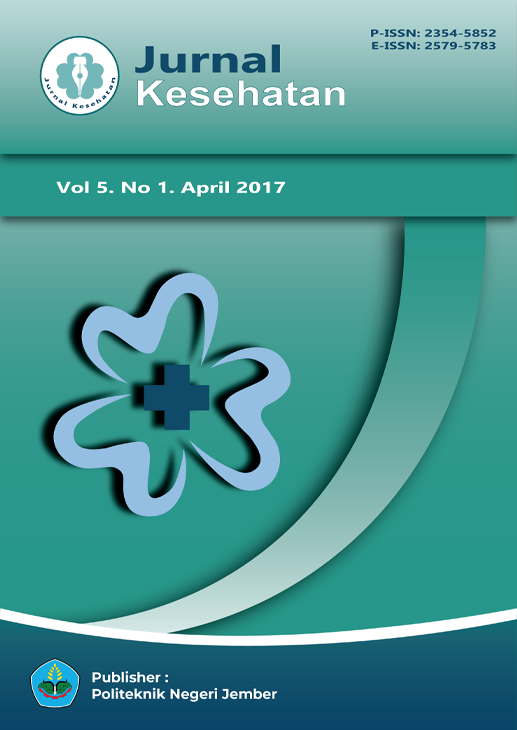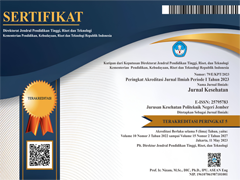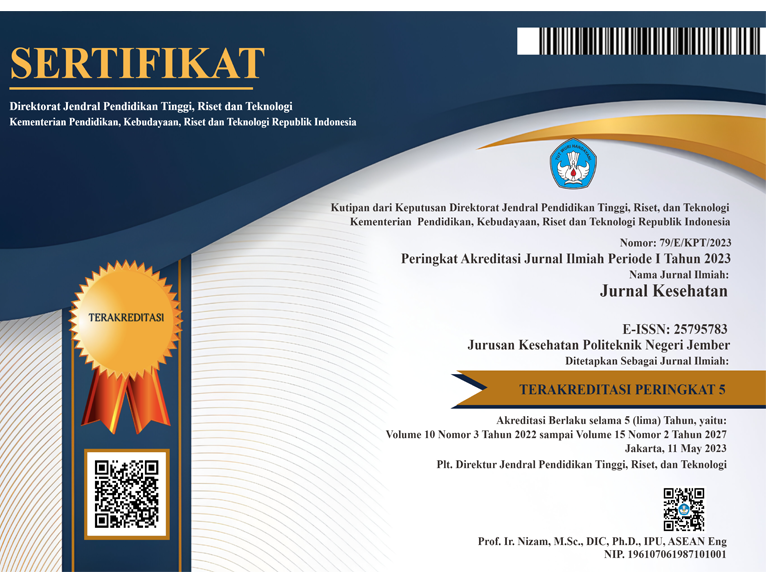Difference of Weight Gain in Baby Mother Given Boiled Of Papaya Fruit
DOI:
10.25047/j-kes.v5i1.36Downloads
Abstract
Babies should be exclusively breastfed for the first 6 months. But the success of exclusive breastfeeding is low. Shown with coverage of exclusive breastfeeding in the Village District of Arjasa Biting Jember is by 30-40%, whereas the target coverage of exclusive breastfeeding in Indonesia is 80%. The reason is the lack of milk production. Efforts are needed to increase milk production. By providing water boiled papaya fruit in nursing mothers can improve milk production. This study aimed to determine differences in weight babies in the treatment group with the control group. The research method used in this research is the design of Quasi Experimental "Non-Equivalent Control Group Design". Sampling technique using accidental sampling by respondents as many as 28 nursing mothers. Scale ratio data with independent t-test test gained an average weight gain of treatment and control group infants at 279,78 and 179,36. Analysis SPSS statistical test obtained t count > t table (3,86 > 2.160). Thus Ho is rejected, meaning that there are differences in weight babies in the treatment group with the control group. That is because the boiled papaya fruit contain saponins and alkaloids which can affect the production of prolactin and oxytocin. With the significant results expected health workers can provide information to breastfeeding mothers that water boiled papaya fruit can increase milk production.
Keywords:
Boiled of Papaya fruit, Breast Milk Production, Baby WeightReferences
Akbar, M. dkk. (2013). Produksi Air Susu Induk dan Tingkat Mortalitas Anak Kelinci yang diberi Pakan Tambahan Tepung Daun Katuk (Sauropus Androgynus L. Merr)
Arini. (2012). Mengapa Seorang Ibu harus Menyusui. Yogjakarta: FlashBooks. Arisman.( 2010). Buku Ajar Ilmu Gizi- Gizi dalam Daur Kehidupan Edisi 2. Jakarta: EGC
Beck, M.E.( 2000). Ilmu Gizi dan Diet Hubungan dengan Penyakit- Penyakit untuk Perawat dan Dokter. Yogyakarta: Yayasan Essentia Medica
Bobak, M. Irene, et. al. (2005). Buku Ajar Keperawatan Maternitas. Edisi 4. Alih Bahasa : Maria A, Wijayarini. Jakarta: EGC
Dinas Kesehatan Jawa Timur. (2013). Profil Kesehatan Provinsi Jawa Timur Tahun 2012
Emfud Machfuddin, (2004). Patofisiologi Pembentukan Asi, Departemen Obstetri dan Ginekologi Fakultas Kedokteran Universitas Sriwijaya
Goodman & Gilman. (2001). Goodman & Gilman Dasar Farmakologi Terapi. Eds 10. Alih Bahasa : Hardman. J.G & Limbird, L.E, pp 240- 275. Jakarta: EGC
Gunawan, D. & Mulyani, S. (2010). Ilmu Obat Alam (Farmakognosi) Jilid 1. Jakarta: Penebar Swadaya
Harimukti, Indri. (2013). Kandungan Saponin dan Flafvonoid pada Daun Pepaya (Carica papaya L) Akibat Perebusan bersama Daun Singkong (Manihoi utilissima).
Herlina Widyoningrum dan Tini, (2011). Solusi Alternatif Kitab Taman obat Nusantara. Yogyakarta : Medpress
Karisma, Y, Armaya A, Herri S. (2011). Efek Ekstrak Air Buah Pepaya (Carica papaya L) Muda terhadap Gambaran Histologi Kelenjar Mamma Mencit Laktasi. 160-165
Lingga, Lanny. (2010). Cerdas Memilih Sayuran. Jakarta : PT Agro Media Pustaka
Manuaba, I.B.G., I.A. Chandranita Manuaba, dan I.B.G. Fajar Manuaba. Pengantar Kuliah Obstetri. Jakarta: Buku Kedokteran EGC, 2007
Meutia, A.A. & Kusnadi, J. Ekstraksi Antioksidan dari Buah Pepaya (Carica Papaya L) dengan Menggunakan Metode Ultrasonic Bath (kajian Kematangan Pepaya dan Proporsi Volume Pelarut: Bahan)
Murtiana, T, (2011). Pengaruh Konsumsi Daun Katuk dengan Peningkatan Produksi ASI pada Ibu Menyusui di Wilayah Puskesmas Sawah Lebar Kota Bengkulu Tahun 2011. Jurusan Kebidanan, Politeknik Kesehatan Bengkulu, Bengkulu.
Notoatmojo, Soekidjo. (2010). Metodologi Penelitian Kesehatan. Jakarta: Rineka Cipta
Nursalam.( 2009). Konsep dan Penerapan Metodologi PenelitianIlmu Keperawatan. Jakarta: Salemba Medika
Provera, W. & Rahmawati, E. (2010). Kapita Selekta ASI & Menyusui. Yogyakarta: Nuha Medika
Saefudin, Malik. (2011). Metodologi Penelitian Kesehatan Masyarakat. Jakarta: TIM Sarker, S.D. & Nahar, L. (2009). Kimia untuk Mahasiswa Farmasi Bahan Kimia
Organik, Alam dan Umum. Yogyakarta: Pustaka Pelajar
Setyaningsih, D. & Sediawan, W.B. (2004). Kesetimbangan Papain dalam Getah Padat dan Air pada Ekstraksi Papain: Variasi kadar NaHSO3 dalam Air.
Sugiyono.( 2012). Statistika untuk Penelitian. Jakarta: IKAPI
Suradi & Kristina (Ed). (2004). Manajemen Laktasi Cetakan ke 2. Jakarta: Program Manajemen Laktasi Perkumpulan Perinatologi Indonesia
Syaifuddin.( 2006). Anatomi Fisiologi untuk Mahasiswa Keperawatan. Jakarta: EGC Syamsudin. (2011). Buku Ajar Farmakologi Efek Samping Obat. Jakarta: Salemba Medika
Wiji, R.N. (2013). ASI dan Panduan Ibu Menyusui. Yogyakarta: Nuha Medika
License
Copyright (c) 2017 Susilawati Susilawati, Nining Chusnul Chotimah

This work is licensed under a Creative Commons Attribution-ShareAlike 4.0 International License.
Authors who publish in this journal agree to the following terms:
1. Copyright belongs to the medical journal as a publication
2. The author retains copyright and grants the journal rights to the first publication carried out simultaneously under a Creative Commons Attribution License which allows others to share the work with an acknowledgment of the author's work and initial publication in this journal.
3. Authors may enter into separate additional contractual arrangements for the non-exclusive distribution of the work (eg sending it to an institutional repository or publishing it in a book) with acknowledgment of initial publication in this journal.
4. Authors are permitted and encouraged to post work online (eg in institutional repositories or on their websites) before and during the submission process, as before and larger citations of published work (see Effects of Open Access).
Selengkapnya tentang teks sumber ini














